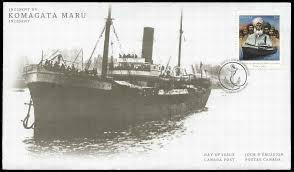On 28 July 1914, The S.S Komagata Maru was forced to leave Vancouver and sailed for India.
The Komagata Maru incident involved the Japanese steamship Komagata Maru, on which a group of citizens of the British Raj attempted to emigrate to Canada in 1914, but were denied entry and forced to return to Calcutta (present-day Kolkata), India. There they were fired upon by Indian Imperial Police, resulting in the deaths of 20 Sikhs.
Komagata Maru sailed from British Hong Kong, via Shanghai, China, and Yokohama, Japan, to Vancouver, British Columbia, Canada, in 1914, carrying 376 passengers from Punjab, British India. Of them, 24 were admitted to Canada, but the other 352 passengers were not allowed to disembark in Canada, and the ship was forced to return to India.The passengers comprised 337 Sikhs, 27 Muslims and 12 Hindus, all Punjabis and British subjects. This was one of several incidents in the early 20th century in which exclusion laws in Canada and the United States were used to exclude immigrants of Asian origin.






